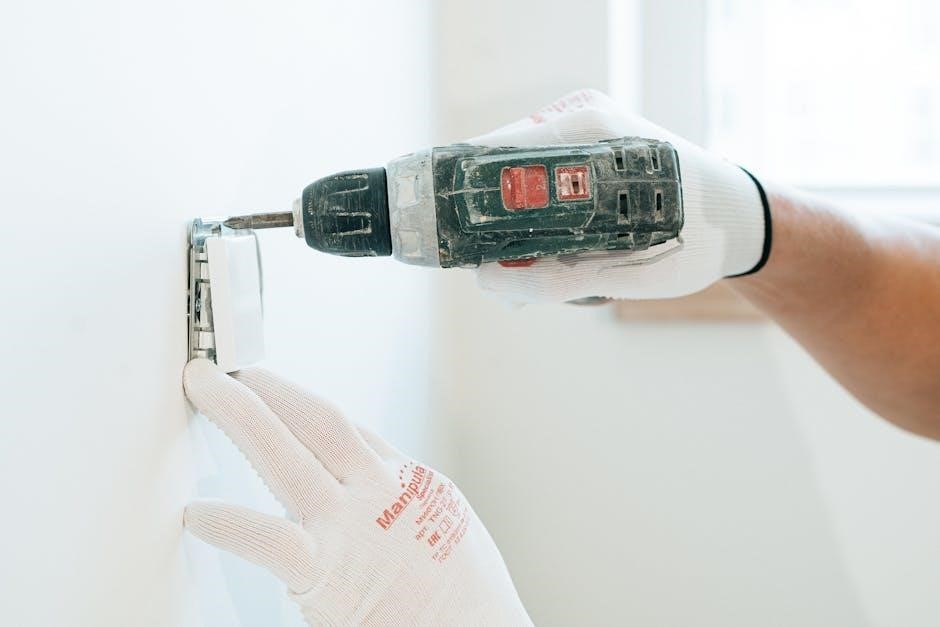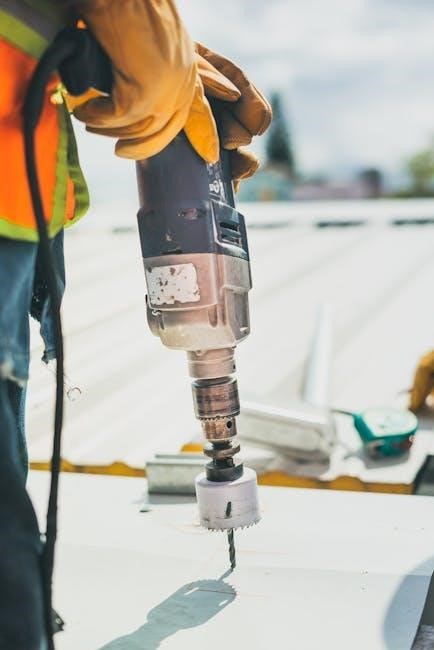Safety Precautions
1.1; General Safety Guidelines
Ensure all power sources are disconnected before installation. Only qualified personnel familiar with AC drives should perform installation, start-up, and maintenance to avoid personal injury or equipment damage.
1.2. Electrostatic Discharge (ESD) Protection
Static control precautions are required. Use ESD protection devices when handling components. Failure to follow ESD procedures may result in component damage. Reference publication 8000-4.5.2 for details.
1.3. Lock-Out/Tag-Out Procedures
Turn off and lock out all input power, including external sources. Verify no voltage at drive terminals before starting work. Follow proper lock-out/tag-out steps to ensure safe installation and maintenance.
Always ensure all power sources are disconnected before starting installation. Only qualified personnel familiar with adjustable frequency AC drives should perform installation, start-up, and maintenance to prevent personal injury or equipment damage. Review all safety precautions in the manual before proceeding. Proper training and understanding of drive operations are essential. Wear appropriate personal protective equipment, including safety glasses and insulating gloves, when handling electrical components. Ensure the work area is clear of hazards and properly ventilated. Follow all local safety regulations and guidelines. Never bypass safety devices or ignore warning labels on the equipment. Proper safety practices are critical to ensuring a safe and successful installation.
The PowerFlex 755 drive contains ESD-sensitive components. Static control precautions are required during installation, testing, or servicing to prevent component damage. Use appropriate ESD protection devices, such as wrist straps or conductive mats, to ground yourself before handling sensitive parts. Ensure the work area is static-protected. If unfamiliar with ESD control procedures, reference publication 8000-4.5.2 or other applicable ESD protection handbooks. Component damage can occur if ESD protection procedures are not followed. Proper grounding and static control measures are critical to safeguarding the equipment and ensuring reliable operation.
Before performing any work on the PowerFlex 755 drive, ensure all power sources are disconnected. Turn off and lock out the input power, including any external DC power sources, and verify no voltage remains at the drive terminals. Wait 15 minutes to allow capacitors to discharge. Measure the DC bus voltage at the -DC and DC TESTPOINT sockets to confirm it is safe to proceed. Secure the drive circuit breaker (SW5) and disconnect switch (SW2) in the off position. Follow proper lock-out/tag-out procedures to ensure safety during installation, maintenance, or servicing. Only qualified personnel should execute these steps to prevent injury or equipment damage. Always reference Rockwell Automation Publication 750-IN037A-EN-P for detailed instructions.

System Requirements
Ensure the PowerFlex 755 drive is compatible with your motor and load. Verify environmental conditions, such as temperature and humidity, meet specified ranges. Confirm power supply requirements match the drive’s ratings for proper operation.
2.1. Compatible Motor and Load Requirements
The PowerFlex 755 drive is designed for use with three-phase induction and synchronous motors. Ensure the motor’s power rating matches the drive’s output. Verify the motor’s voltage and frequency ratings are compatible with the drive’s specifications; The drive supports a wide range of motor control applications, including variable torque and constant torque loads. Proper motor and load matching ensures optimal performance and prevents potential damage. Always refer to the drive’s technical specifications and motor nameplate data for compatibility verification. Proper alignment of motor and load characteristics is crucial for efficient operation and longevity of the system.
2.2. Environmental Considerations
Ensure the PowerFlex 755 drive is installed in an environment with a temperature range of 0°C to 40°C (32°F to 104°F) and humidity levels below 95% non-condensing. Avoid exposure to direct sunlight, moisture, or airborne contaminants. The drive must be mounted in a well-ventilated area to prevent overheating. For outdoor installations, use a NEMA/UL Type 4 or 4X-rated enclosure to protect against dust, water, and corrosive agents. Ground the drive properly to prevent electrical noise and ensure safe operation. Verify local regulations for environmental compliance. Proper environmental conditions ensure reliable performance and extend the drive’s lifespan. Always follow Rockwell Automation’s guidelines for specific installation scenarios.
2.3. Power Supply Requirements
Ensure the power supply meets the drive’s specifications, providing the correct voltage and current ratings. For DC input drives, verify the precharge module compatibility. Disconnect all power sources, including external DC power, before installation. Measure DC bus voltage at the -DC and DC TESTPOINT sockets to confirm power is off. Secure the drive’s circuit breaker (e.g., SW5) and disconnect switch (SW2) to prevent accidental power-up. Ensure the power supply is properly grounded and meets local electrical codes. Use a 120V uninterruptible power supply for control circuits. Follow torque specifications for terminal connections (e.g., 1.8 N·m) to avoid damage. Verify all connections before applying power.

Pre-Installation Steps

Review all documentation, including installation manuals and safety guidelines. Verify the unpacked components match the order. Prepare the site, ensuring proper environmental conditions and necessary tools are available.
3.1. Unpacking and Inventory
Carefully unpack the PowerFlex 755 drive and all components from the shipping container. Verify each item against the packing list to ensure completeness. Inspect for visible damage or discrepancies. Ensure all modules, cables, and accessories are included. Review the parts list provided in the installation manual to confirm receipt of all necessary items. Only qualified personnel should handle the equipment. Store components in a dry, secure area to prevent damage. Check for any shipping-related issues and report them immediately to avoid installation delays. Properly organize and label all parts for efficient installation. Follow all safety guidelines during unpacking to prevent personal injury or component damage.
3.2. Reviewing Documentation
Thoroughly review all provided documentation, including the PowerFlex 755 installation manual (Publication 750-IN001) and any frame-specific guides. Verify compatibility of the drive with your motor and load requirements. Ensure you understand safety precautions, wiring diagrams, and installation steps. Check for any software or firmware updates required before proceeding. Familiarize yourself with the hardware components and their functions. Review the site preparation checklist to ensure the environment meets necessary conditions. Consult additional resources like the Rockwell Automation website for supplementary guides or technical bulletins. Proper documentation review is critical for a successful and safe installation process. Always follow the latest version of the manual for accurate instructions.
3.3. Site Preparation
Ensure the installation site meets all environmental and safety requirements. Verify the enclosure meets NEMA/UL standards for the specified drive model. Properly ground the enclosure to prevent electrical hazards. Ensure adequate cooling and ventilation to maintain the recommended operating temperature range. Verify the power supply matches the drive’s requirements, including voltage, phase, and frequency. Check for any environmental constraints such as humidity or dust levels that may affect performance. Ensure all necessary tools and materials are available. Prepare the mounting surface to ensure proper alignment and secure installation. Adhere to the specifications outlined in the PowerFlex 755 installation manual for optimal performance and longevity of the drive.

Hardware Installation
Mount the drive securely, ensuring proper alignment and torque specifications. Install option modules and connect power and motor cables according to the manual’s guidelines for optimal performance.
4.1. Mounting the Drive
Mount the PowerFlex 755 drive in a user-supplied enclosure, ensuring compatibility with the drive’s frame size and type. Secure the drive using the provided mounting hardware, following torque specifications to avoid damage. Ensure the enclosure provides adequate ventilation and meets environmental requirements. Properly align the drive within the enclosure to facilitate cable connections and maintenance access. Install grounding connections to prevent ESD and ensure safe operation. Verify that all mounting screws are tightened to the recommended torque to prevent vibration and ensure reliable performance. Follow the manual’s guidelines for enclosure preparation and drive alignment to maintain optimal functionality and safety during operation.
4.2. Installing Option Modules
Before installing option modules, ensure the drive is powered off and properly grounded. Access the module slots by removing the relevant cover. Insert the module firmly into its slot, ensuring it is fully seated and aligned. Secure the module with the provided screws, following the torque specifications in the manual. Reassemble any covers and reconnect power. Verify module installation by checking for proper communication and functionality. Refer to the specific module’s installation guide for detailed instructions. Always use genuine Rockwell Automation modules to ensure compatibility and performance. Follow all safety guidelines to prevent damage or injury during the installation process.
4.3. Connecting Power and Motor Cables
Ensure the drive is powered off before connecting cables. Connect the power cables to the drive’s input terminals, ensuring correct phase alignment; Verify cable gauge matches the drive’s specifications. Securely tighten all connections using the recommended torque. For motor cables, connect them to the drive’s output terminals, following the same alignment and torque guidelines. Double-check all connections for tightness and proper routing. Ground the drive and motor according to local electrical codes. Use shielding for motor cables to minimize noise. Refer to the manual for specific wiring diagrams and recommendations. Always follow safety standards and ensure compliance with UL and NEC requirements for safe installation.

Software Configuration
Configure drive parameters using RSLogix or RSLinx tools. Set motor and application-specific parameters, then enable network communication for integration. Advanced features like Device Level Ring (DLR) can be enabled for enhanced control.

5.1. Parameter Setup
Parameter setup is critical for proper drive operation. Use RSLogix or RSLinx software to configure motor and application-specific settings. Enter motor nameplate data, including rated voltage, current, and frequency. Set the motor control mode (V/Hz or sensorless vector) and select the appropriate motor type. Configure acceleration and deceleration times, as well as torque limits, to match application requirements. Define I/O configurations for control signals and ensure all safety parameters are enabled. Verify all settings align with the connected motor and load. Save the configuration to ensure consistency across power cycles. Proper parameter setup ensures optimal performance and prevents potential operational issues. Always refer to the manual for specific parameter details.
5.2. Network Communication Configuration
Configure network communication to enable device-level networking. Use Ethernet/IP for seamless integration with Rockwell Automation systems. Set the IP address, subnet mask, and gateway using RSLogix software. Ensure proper baud rate and DLR (Device Level Ring) topology configuration for high-speed communication. Enable network parameters like IP address and port settings to match your system architecture. Test communication by pinging the drive or using RSLinx to verify connectivity. Configure I/O data and explicit messaging for efficient data transfer. Ensure all network settings align with your control system requirements. Proper configuration ensures reliable communication and optimal performance. Refer to the manual for detailed instructions on advanced network settings and troubleshooting connectivity issues.
5.3. Advanced Features Setup
Configure advanced features like TotalFORCE control for high-performance applications. Enable adaptive tuning for optimal motor performance. Set up motion control profiles for precise positioning. Configure energy-saving features to reduce power consumption. Use RSLogix 5000 software to program custom logic and parameters. Enable Device Level Ring (DLR) for high-speed peer-to-peer communication. Set up safety functions like hardwired safe torque-off. Configure additional I/O and auxiliary control options. Ensure all advanced features align with application requirements. Refer to the manual for detailed parameter settings and configuration steps. Proper setup of these features enhances drive performance, efficiency, and integration with control systems. Verify configurations through diagnostic tools to ensure optimal operation.

Start-Up and Testing
Power on the drive, check for error codes, and verify motor operation. Test communication settings and ensure proper sequencing. Refer to the manual for troubleshooting common issues during start-up.
6.1. Power-On Sequence
Ensure all power sources are disconnected and locked out. Wait 15 minutes to allow capacitors to discharge. Verify no voltage at the drive input terminals using a multimeter.
Measure DC bus voltage at the -DC and DC TESTPOINT sockets on the power module front. Ensure it is zero before proceeding.
Turn on the drive circuit breaker (SW5) and disconnect switch (SW2). Check for any error messages on the display or through connected communication networks.
Secure the disconnect handle and shaft using the specified torque (1.8 N·m for screws and 2.8 N·m for set screws).
Power on the drive and monitor its operation. Ensure all safety functions, like safe torque-off, are enabled and functioning correctly.
6.2. Initial Testing and Verification
After powering on, verify the drive display shows normal operation. Check for any error or fault codes and clear them if necessary. Ensure all motor and load connections are secure.
Test communication interfaces like EtherNet/IP or DeviceNet to confirm proper network integration. Monitor drive status through connected HMIs or software tools like RSLogix.
Run the motor at low speed to verify direction and control. Gradually increase speed, observing smooth operation and proper torque delivery.
Review parameter settings to ensure they match application requirements. Verify safe torque-off functionality if enabled.
Document any issues and refer to troubleshooting guides for resolution. Ensure all safety features are operational before full production use.
6.3. Troubleshooting Common Issues
Common issues during start-up may include error codes, communication faults, or motor performance inconsistencies. Consult the drive’s display for specific error messages and refer to the manual for troubleshooting steps.
For communication issues, verify network settings and connections. Ensure EtherNet/IP or other adapters are properly configured. Restart the drive and check if the problem persists.
For motor-related faults, check parameter settings and motor sizing. Ensure correct motor cable connections and verify torque and speed parameters match the application requirements.
If overvoltage or undervoltage errors occur, inspect the power supply and verify proper installation of line reactors or filters if required.
Refer to Rockwell Automation’s troubleshooting guides or online support for unresolved issues. Regular updates and maintenance can prevent recurring problems. Always follow safety protocols when troubleshooting.

Maintenance and Upkeep
Regularly inspect and clean the drive, focusing on fans and heat sinks to ensure proper cooling. Replace air filters as needed to maintain optimal performance.
Verify all connections and cables for integrity. Check for signs of wear or damage and address issues promptly to prevent unexpected downtime.
Perform firmware updates as recommended by Rockwell Automation. Refer to the maintenance schedule in the manual for specific tasks and intervals to ensure longevity and reliability.
7.1. Scheduled Maintenance Tasks
Perform routine inspections every 6 months, including checking fans, heat sinks, and internal components for dust buildup. Clean as needed to maintain proper cooling and functionality.
Inspect power and motor cables for wear or damage. Tighten all connections to ensure reliability. Verify proper torque specifications to prevent loose connections and potential faults.
Monitor drive performance and log operational data. Replace air filters every 12 months or as conditions dictate. Schedule firmware updates to maintain optimal drive performance and security.
7.2. Updating Firmware
Regularly update the PowerFlex 755 firmware to ensure optimal performance and security. Check the Rockwell Automation website for the latest firmware versions. Before updating, back up all drive parameters and configurations. Use a USB or SD card for firmware updates, ensuring the media is formatted correctly. Do not interrupt the update process, as this may cause irreversible damage. Follow the instructions provided in the firmware update manual carefully. After completion, verify the update by checking the drive’s version information. Always use firmware approved by Rockwell Automation to maintain compatibility and reliability.
7.3. Cleaning and Inspection
Regular cleaning and inspection are crucial for maintaining the PowerFlex 755 drive’s performance and longevity. Use compressed air or anti-static wipes to clean dust and debris from the drive and its components. Inspect all connections and cables for signs of wear or damage. Check the DC bus voltage and ensure all screws are tightened to the specified torque values. Verify that cooling fans are operational and free from obstructions. Refer to Rockwell Automation guidelines for detailed inspection procedures. Address any issues promptly to prevent downtime or equipment failure. Always follow proper ESD precautions when handling internal components to avoid damage.

Additional Resources
Refer to Rockwell Automation publications, such as the PowerFlex 755 Installation Manual (Publication 750-IN001) and online support resources. Visit www.rockwellautomation.com for additional guides, manuals, and technical support contact information.
8.1. Rockwell Automation Publications
Key publications for PowerFlex 755 installation include the PowerFlex 755 Installation Instructions Manual (Publication 750-IN001) and the PowerFlex 750-Series AC Drives Safety Reference Manual. These documents provide detailed guidance on mechanical and electrical installation, safety protocols, and troubleshooting. Additional resources like the PowerFlex 755 Configuration Manual and Maintenance Schedule are also available. Visit the Rockwell Automation website at www.rockwellautomation.com/literature to access these publications. For further assistance, contact your local Allen-Bradley distributor or Rockwell Automation sales representative.
8.2. Online Support and Manuals
8.3. Contact Information for Support
For assistance with the PowerFlex 755 installation, contact Rockwell Automation’s support team. Visit their official website at www.rockwellautomation.com for regional contact details. You can also reach out to your local Allen-Bradley distributor or Rockwell Automation sales representative for technical support and documentation. Additionally, Rockwell Automation provides a dedicated support line for immediate inquiries. Ensure to gather necessary details about your product before contacting support for efficient assistance. For product returns or repairs, follow the procedures outlined on their website to ensure compliance with their policies. This ensures timely and effective resolution to any issues during or after installation.
